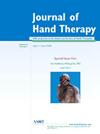Effectiveness of a scapular exercise program on functional outcomes in patients with hand, wrist or elbow disorders: A comprehensive systematic review with meta-analysis
IF 1.8
4区 医学
Q2 ORTHOPEDICS
引用次数: 0
Abstract
Background
Usually, patients with hand, wrist/forearm disorders report musculoskeletal complaints in the shoulder. Although, role of scapula is fundamental for movement and functional stability across the upper limb kinetic chain; however, there are no systematic reviews and meta-analyses that have analyzed the effect of scapular exercises in these patients.
Purpose
This study aimed to determine the effectiveness of a scapular exercise program on functional outcomes in patients with hand, wrist or elbow disorders.
Study Design
Systematic review with meta-analysis.
Methods
An electronic search was performed of the MEDLINE, EMBASE, Web of Science, Scopus, CENTRAL, Epistemonikos, CINAHL, SPORTDiscus, PEDro, and LILACS databases. The eligibility criteria included randomized clinical trials that investigated the effects of scapular exercises added to a conventional physiotherapy program on functional outcomes in patients with hand, wrist or elbow injuries or pathologies. Two authors independently performed the search, study selection, data extraction, and risk of bias assessment.
Results
Six trials met the eligibility criteria and were included in the quantitative synthesis. For the comparison of scapular exercises plus conventional physiotherapy versus conventional physiotherapy alone, the mean difference for elbow and wrist function was 7.6 points (p = 0.04), upper limb function was 16.1 points (p < 0.01), grip strength was 15.4% (p = 0.01), pain free grip strength was 19.1 N (p = 0.13) and pain intensity at rest was −1.1 cm (p < 0.01). Additionally, there was a significant increase in muscle strength of serratus anterior 46.2 N (p < 0.01), middle trapezius 29.9 N (p = 0.01) and lower trapezius 45.9 N (p < 0.01).
Conclusions
In the short term, adding scapular exercises to conventional physiotherapy showed statistically significant differences in functional outcomes in patients with lateral elbow tendinopathy and distal radius fracture. However, most of these differences did not reach the minimum threshold to be considered clinically important. The evidence strength was high to low according to the GRADE approach. More quantity and quality of clinical trials is needed to confirm our findings.
PROSPERO Registration
CRD42022364829.
肩胛骨锻炼计划对手、腕或肘部疾病患者功能结局的有效性:一项综合系统综述和荟萃分析
背景:通常,手、腕/前臂疾病的患者报告肩部肌肉骨骼主诉。尽管肩胛骨的作用对于整个上肢运动链的运动和功能稳定至关重要;然而,目前还没有系统的综述和荟萃分析分析肩胛骨运动对这些患者的影响。目的:本研究旨在确定肩胛骨锻炼计划对手、腕或肘部疾病患者功能结局的有效性。研究设计:采用荟萃分析的系统评价。方法:电子检索MEDLINE、EMBASE、Web of Science、Scopus、CENTRAL、Epistemonikos、CINAHL、SPORTDiscus、PEDro、LILACS数据库。入选标准包括随机临床试验,研究在常规物理治疗方案的基础上进行肩胛骨锻炼对手部、手腕或肘部损伤或病变患者功能结局的影响。两位作者独立完成了检索、研究选择、数据提取和偏倚风险评估。结果:6项试验符合入选标准,纳入定量综合。肩胛骨运动加常规物理治疗与单纯常规物理治疗比较,肘关节和手腕功能的平均差异为7.6分(p = 0.04),上肢功能的平均差异为16.1分(p)。结论:在短期内,常规物理治疗加肩胛骨运动对肘关节外侧肌腱病变和桡骨远端骨折患者的功能结局有统计学意义。然而,这些差异中的大多数没有达到被认为具有临床重要性的最低阈值。根据GRADE方法,证据强度从高到低。需要更多数量和质量的临床试验来证实我们的发现。普洛斯彼罗注册:CRD42022364829。
本文章由计算机程序翻译,如有差异,请以英文原文为准。
求助全文
约1分钟内获得全文
求助全文
来源期刊

Journal of Hand Therapy
医学-外科
CiteScore
3.50
自引率
10.00%
发文量
65
审稿时长
19.2 weeks
期刊介绍:
The Journal of Hand Therapy is designed for hand therapists, occupational and physical therapists, and other hand specialists involved in the rehabilitation of disabling hand problems. The Journal functions as a source of education and information by publishing scientific and clinical articles. Regular features include original reports, clinical reviews, case studies, editorials, and book reviews.
 求助内容:
求助内容: 应助结果提醒方式:
应助结果提醒方式:


